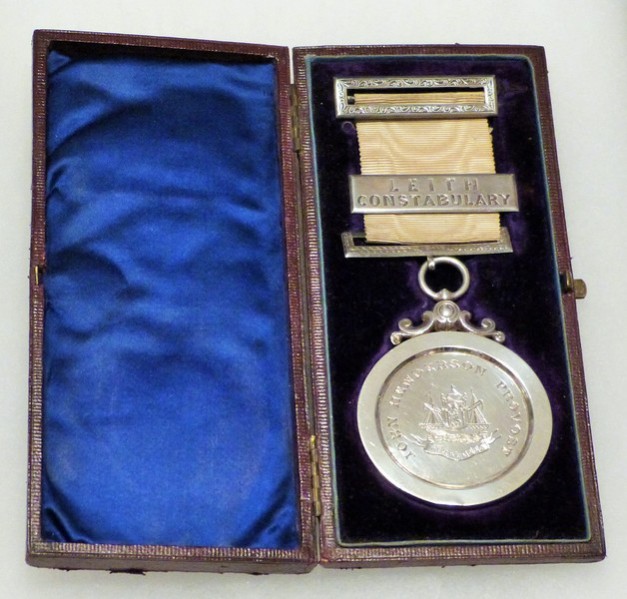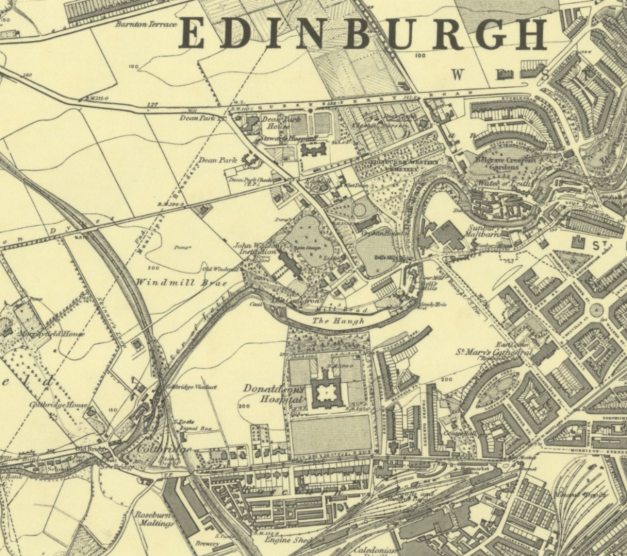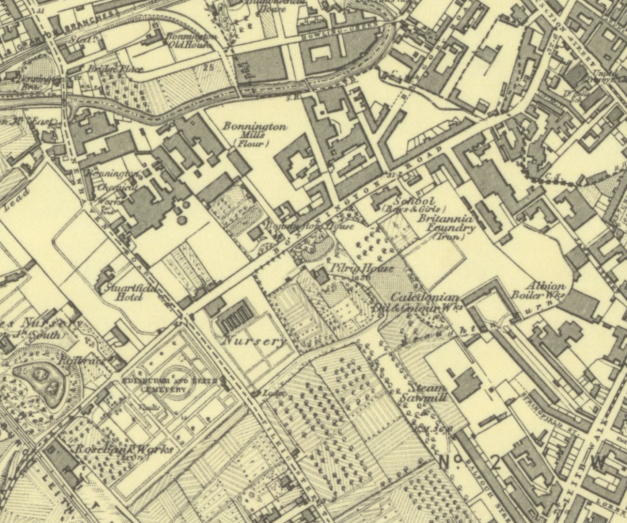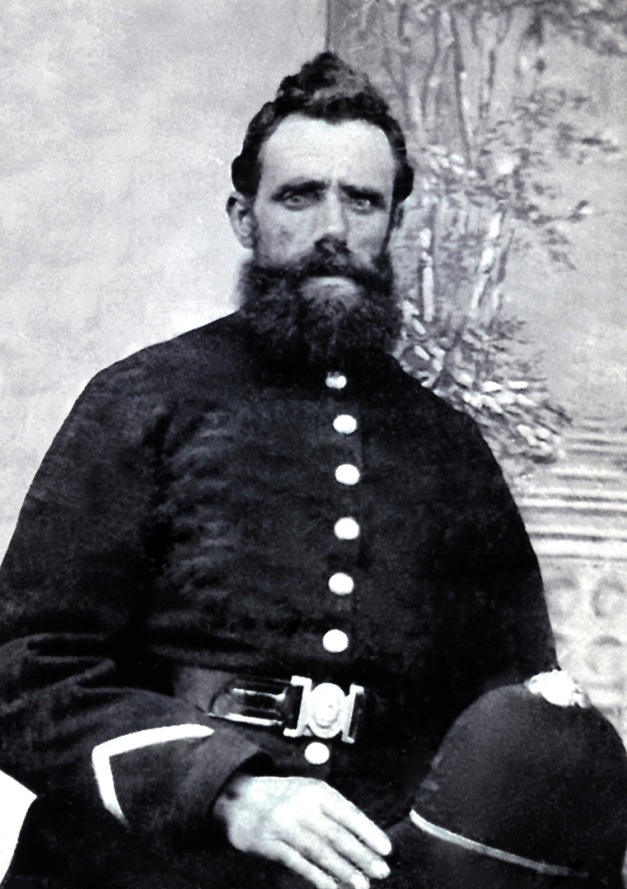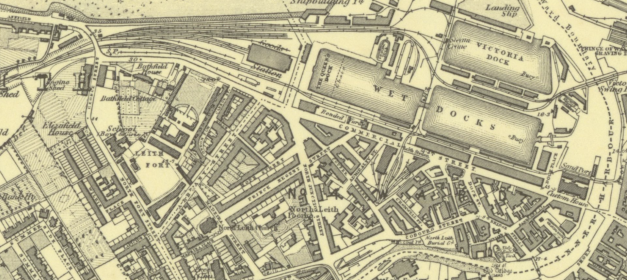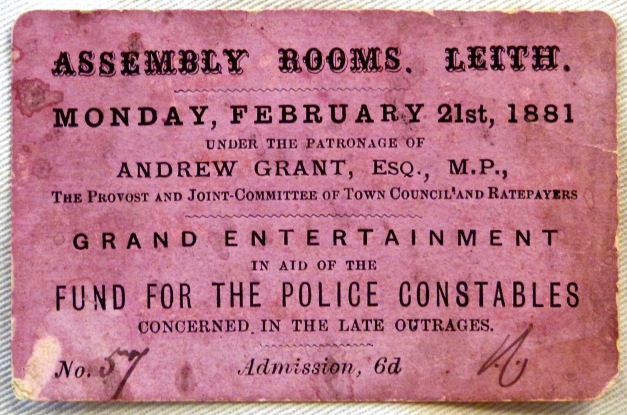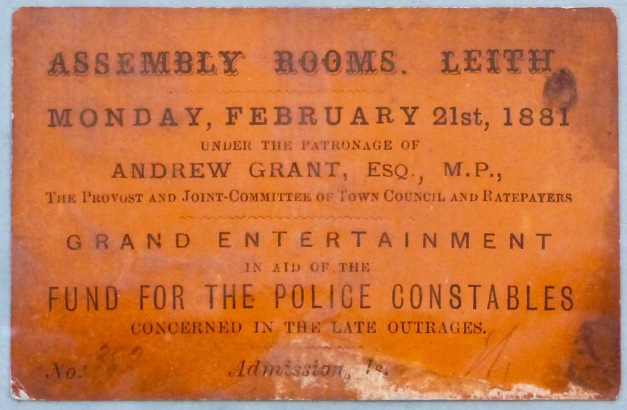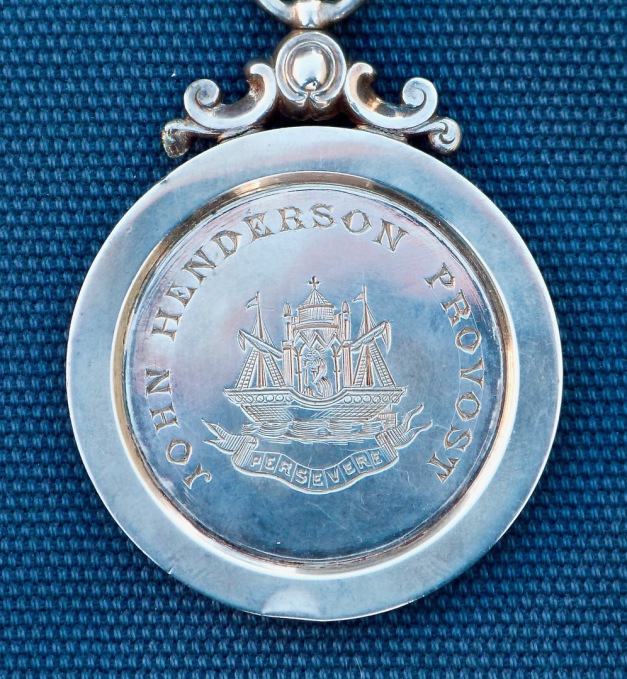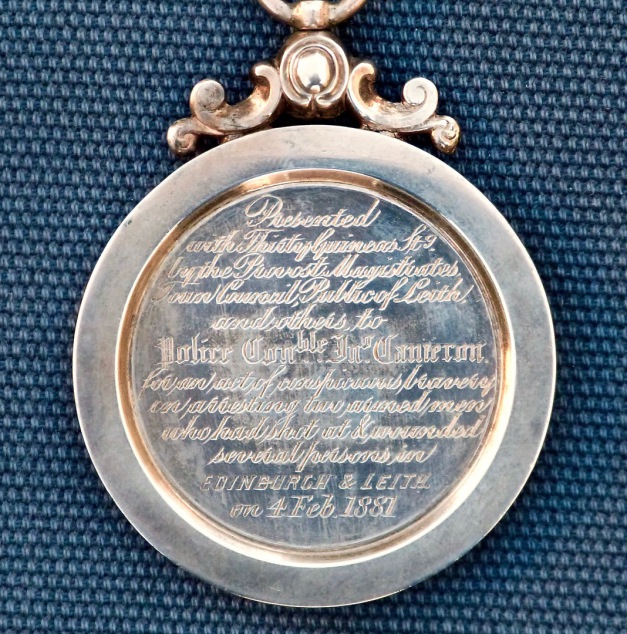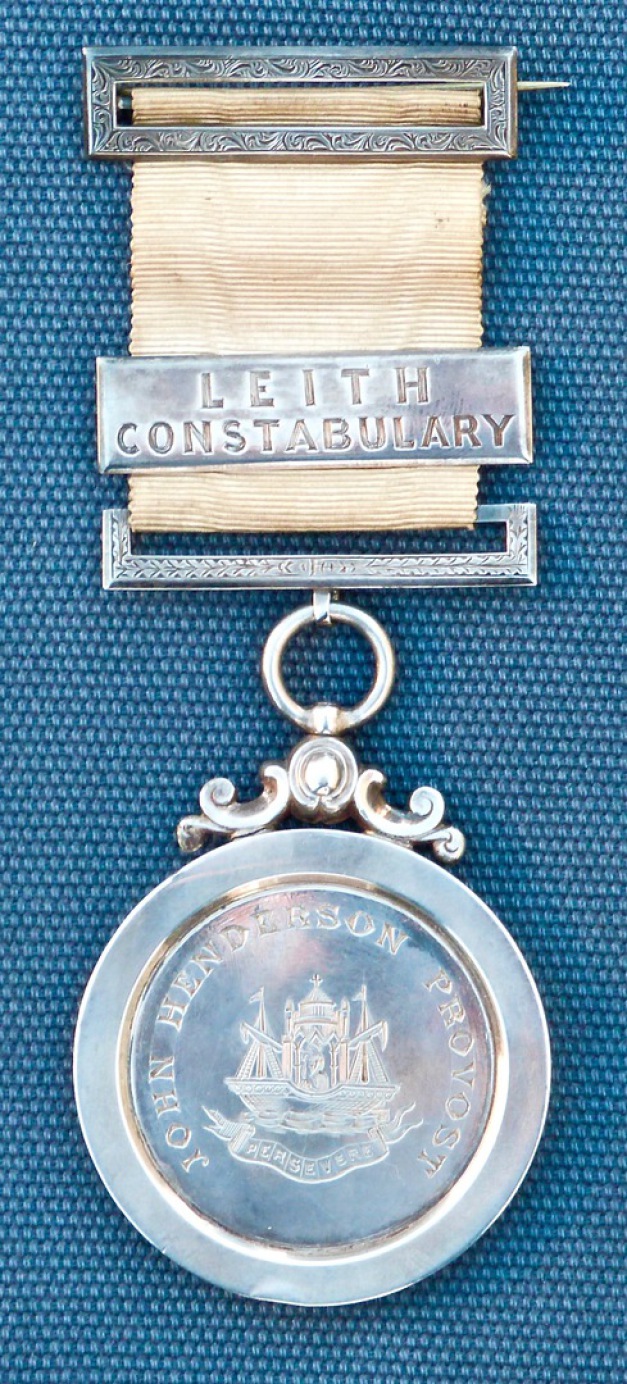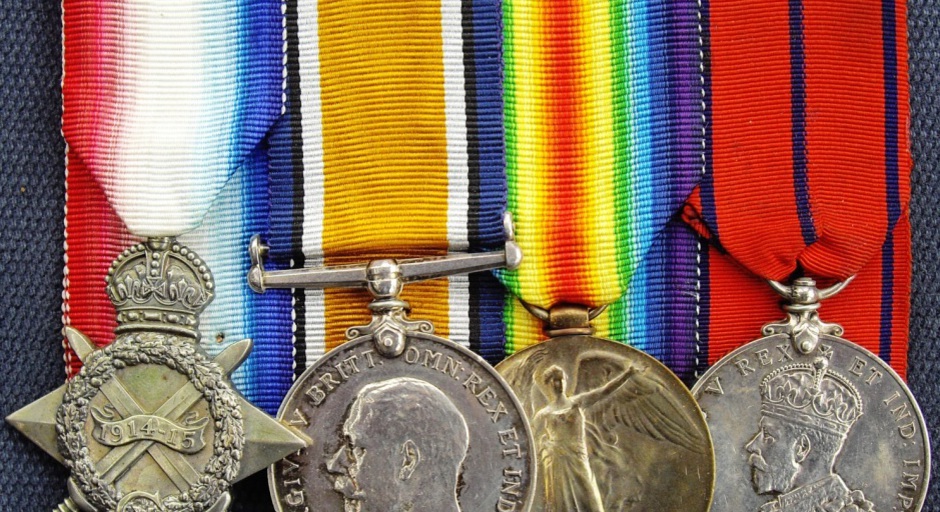
'The Outrages in Edinburgh & Leith, 1881'
The Leith Constabulary Medal for Conspicuous Bravery, 1881
On Thursday, 2 June, 1881, at the Assembly Rooms in Constitution Street, Leith in the County of Edinburgh, Dr John Henderson, Provost (Mayor) of the Burgh of Leith, presented six police officers of the local constabulary with an individually inscribed silver medal and 30 guineas.[i] The medals were inscribed on the reverse:
“Presented with thirty guineas by the Provost, Magistrates, Town Council, public of Leith and others to (name of officer) for an act of conspicuous bravery, in arresting two armed men who had shot and wounded several persons in Edinburgh and Leith on the 4th of February, 1881.”
The obverse was inscribed around the centre with “John Henderson Provost” and the Burgh of Leith coat of arms. The medal illustrated in this story was awarded to PC John Cameron, born on 27 October, 1844 in Duthil and Rothiemurchus in the County of Inverness. [ii]
[i] 1 guinea = 21 shillings, (20 shillings in one pound sterling).
[ii] www.scotlandspeople.gov.uk, (O.P.R. Births 096/0B 0030 0079).
The Events that lead to the Presentation
The remarkable story of how these awards came to be made began in November, 1880 when a ship called ‘The Melbourne’ departed Melbourne Harbour in Australia arriving in late January 1881 at East India Docks in London. Three of the crew paid off there were ‘James Hartnett’, ‘Alfred Seymour’ and ‘Tom Harrison’.
The three had worked their passage from Australia and during the voyage, the Ship’s Captain, Captain Norwood Harrison, found them in possession of ‘English Bull-dog’ revolvers. [i] These were confiscated and returned when they were paid off in London.
‘Hartnett’, ‘Seymour’ and ‘Harrison’ had planned to meet up and travel to Edinburgh by rail two days after their arrival in London but ‘Harrison’ failed to appear and only ‘Seymour and ‘Hartnett’ made the journey north. [ii]
What followed, a series of violent robberies, attempted robberies and attempted murder by shootings, came to be known as ‘The Extraordinary Outrages in Edinburgh and Leith’. The outline of the events below is taken from contemporary reports in The Leith Herald and The Scotsman newspapers.
In 1881, the City of Edinburgh and the Burgh of Leith were separate towns in the County of Edinburgh, now known as Midlothian. The city was quite self-contained and consisted of the chaotic ‘Old Town’ between the castle, Grassmarket, Cowgate, Canongate and the ‘South side’ and the James Craig planned ‘New Town’ built between the 1760s and 1830s in the north.
Leith, was then an important port on the River Forth to the north of Edinburgh.
Dean Park Farm was at the very north western edge of the city boundary with the county and relatively remote and unlit in the year 1881. Coltbridge was a small hamlet at the west side of Edinburgh near Murrayfield, just south of Dean Park.
The First Attempted Robbery near Dean Park Farm, Edinburgh
Shortly before 6.30 pm on Friday 4 February, 1881, Alexander Anderson, a Mason residing in the village of Blackhall in the County of Edinburgh, about one mile west of Dean Park Farm on the Old Queensferry Road, was accosted by two men near the farm. One of the men presented a revolver and demanded he hand over his money. On being told by Mr Anderson that he had no money, the men allowed him to pass on and told him “For God’s sake, don’t tell”. Mr Anderson made his way home and did not report the matter until a few days later. [i]
The Second Attempted Robbery near Dean Park Farm, Edinburgh
On Friday 4 February, 1881, about 6.30 pm, near Dean Park Farm [ii] on the Old Queensferry Road, (now Belford Road), Edinburgh, Robert Veitch, a Commercial Traveller, was approaching the farm where his father, William, was the Grieve (Farm Manager). As he was about 30 yards away, two men presented revolvers at him and demanded money. Mr Veitch thinking it was a joke, told them to go away. Realising it was no joke, he struck one of the men about the head with his umbrella so hard it broke, the man staggered back and he ran between them to his father’s house, being struck on the head with a ‘life-preserver’ (cosh) as he did so.
At Dean Park Farm, he told his father and sister, Emily, what had happened, took a walking stick and with his father, went in pursuit of the men along the Queensferry Terrace towards Ravelston Place (see picture above).
They caught up with the men near Watson’s Orphanage grounds (now the Scottish National Gallery of Modern Art) “a few yards south of the block of houses known as Ravelston Place” [iii] (see picture immediately above),and Robert Veitch ran towards them as both presented their revolvers at him and was shot in the left cheek and right ear. His father was hit three times, but sustained no injury as the bullets lodged in his coat. The two assailants then ran back the way they had come and shot Emily Veitch as she approached them from Dean Park Farm. She was wounded in the thigh and suffered a broken jaw from gunshot wounds. The two gunmen turned east into Back Dean.
A cab drew up outside Ravelston Place and the residents, by now aware of the gunshots, came to assist the wounded. Mr Veitch and his sister were placed in the cab and taken home, only a few hundred yards away. [iv] In the meantime, Mr Blackwood, a Draper, had gone off to report the matter at Stockbridge Police station in the city, an account of which was quickly transmitted to the Central Police Office in the High Street. [v]
The two men escaped in the darkness, one leaving his hat behind in the melee. They were seen by a young woman running at the south side of Daniel Stewart’s Hospital eastwards towards the cemetery in Back Dean. She then lost sight of them.[vi]
Upon receiving the information, Superintendent William Henderson of Edinburgh City Police drove to Dean Park Farm and began an enquiry. His men searched the immediate area without result. He then returned to the Central Police Office. It was here that word of the robbery between Coltbridge and Haymarket reached him from Murrayfield Police Station. [vii]
The Robbery near Coltbridge, Edinburgh
About half past eight, on the road between Coltbridge and Edinburgh, possibly on Haymarket Terrace which is about half a mile south of Dean Cemetery where the two suspects were last seen, James Stewart Dick of Caledonian Terrace, Dalry, Edinburgh was walking with a young woman, Marion McLaren Swan. They were stopped by two men who demanded his money and his hat. Dick handed over 4/- (£0.20p) but refused to hand over his watch. One of the men then struck him four times over the head with a cosh and he struggled and got clear of them. One of the assailants had no hat and he took Mr Dicks’ before decamping eastwards towards Edinburgh. [viii]
Mr Dick and Miss Swan reported the matter to the Sergeant’s wife at Murrayfield Police station. (See map below courtesy of the National Records of Scotland (NRS).
Meanwhile, Chief Constable Henderson began to assemble a force of officers with which to search for the two culprits. [ix]
[i] The Edinburgh Evening News, Wednesday, 16 February, 1881.
[ii] Dean Park Farm is now incorporated into Stewart’s Melville College and no longer identifiable.
[iii] The Scotsman Monday 7 February 1881, Page 5. Johnston Press PLC
[iv] The Scotsman Monday 7 February 1881, Page 5. Johnston Press PLC
[v] The Scotsman Monday 7 February 1881, Page 5. Johnston Press PLC
[vi] The Scotsman Tuesday 24 May 1881, Page 7. Johnston Press PLC
[vii] The Scotsman Monday 7 February 1881, Page 5. Johnston Press PLC
[viii] The Scotsman Tuesday 24 May 1881, Page 7. Johnston Press PLC
[ix] The Scotsman Monday 7 February 1881, Page 5. Johnston Press PLC
The Third Attempted Robbery in Bonnington Road, Leith
Bonnington Road. Leith is approximately 5 miles north-east of Coltbridge.
About half past nine that night, Charles Kenney, a Baker’s van driver was driving a horse and van along Bonnington Road between Powderhall and Rosebank Iron Works (See map below), when he was accosted by two men who dragged him from his vehicle and forced him face down on the road. One of the assailants sat or knelt astride him trapping him while the other attempted to take the money bag which was strapped across his shoulder. There was considerable sum in the money bag and the driver struggled violently. One of the men took out a knife and was about to cut the strap when a woman shouted “Don’t murder the man!” On hearing her shout, both men stood up and ran off empty handed, northwards towards Leith. [i] Mr Kenney was unable to describe the men other than “one was considerably taller than the other”. [ii]
Events at the Customs House in Leith
The Customs House in Commercial Street, Leith is just under one mile north of the incident in Bonnington Road.
About 11.30 pm that night, Sergeants Donald Reid and William Arnott of Leith Burgh Police were on duty giving attention to the Customs House in Commercial Street, Leith near to the East Old Dock when they saw two men acting suspiciously and looking into the windows of the Queen’s Store at the rear of the premises. They kept the two men under observation for a short while, then approached and questioned them as to their behaviour and business in the area. The men replied that they were waiting to board their ship. The sergeants being familiar with the docks were aware the men had given the name of a ship not present in the harbour and asked them to come to the police station nearby at the Old Dock (see map below).
Both men initially came willingly, one with each Sergeant but after walking a few yards in Dock Place, the man with Sergeant Arnott sprang away and attempted to escape. The other man with Sergeant Reid began to struggle and Sergeant Arnott joined his colleague in the struggle. They managed to restrain him and were leading him to the Old Dock when the first man returned and shot Sergeant Reid first in the back and again in the head. The man who had been detained produced a revolver and shot Sergeant Arnott in the mouth, neck and side of the face.
Events in Commercial Street, Leith
The sound of the shots and the Sergeants blowing their whistles alerted other officers nearby and PC John Cameron who was watching insecure premises nearby in Dock Street, ran towards the scene. (The Leith Herald has PC Cameron in Dock Place) [i] He was confronted by the two men running towards him. Both men presented their revolvers and told him to “stand off or be shot”. PC Cameron stood his ground and the men ran past him westwards along Commercial Street. PC Cameron pursued them and despite being repeatedly threatened with being shot, continued blowing his whistle and waving his lamp as he did so.
Constables Alexander Nicholson and George Birse who were on duty further west at the railway gate of the Citadel Dock joined the chase in Commercial Street. Both fugitives fired at the two constables and PC Nicholson was wounded slightly on his right knee.
Constable Thomas McConville returning from informing the key-holder of the premises that PC Cameron had been guarding, heard the shots and whistles and joined in the chase from further up (west) Commercial Street. One of the fugitives fired at PC McConville but missed. The lighter of the two men turned into Admiralty Street,[ii] just off Commercial Street. Quickly realising it was a dead end, the fugitive turned to come back into Commercial Street and was immediately confronted by PC McConville.
This man then crossed the road to the Dock wall, placed his back to it and began firing randomly at the four Constables. Constable Cameron, the wounded PC Nicholson and PC Birse continued to pursue the other man west in Commercial Street. [iii] This man becoming aware of his fellow fugitives plight against the wall, turned around and attempted to fire shots at the three Constables but his gun did not go off. [iv]
PC McConville approached the man against the Dock wall and
“…as he did so, a bullet whizzed past his ear and before he could get nearer, the man, still standing against the wall, took two steps to the left and without uttering a word, put the gun to his own mouth, fired and fell instantly to the street”. [v]
PC McConville (See image below), remained with the deceased in Commercial Street immediately opposite Admiralty Street (See map below).
Events in Albany Street, Argyle Street and Hope Street, Leith
The remaining fugitive continued to aim shots at the three Constables as he moved along Commercial Street, south into Albany Street,[vi] east into Argyle Street and south into Hope Street (See G on Map 1 above). [vii] When it became obvious he was beginning to tire and stopped to lean against a wall.
The fugitive placed the gun to his temple and three times he pulled the trigger. Each time, the gun failed to go off. The officers surrounded him and PC Birse arrested the man. As he was arrested, he handed the gun, a revolver marked “British Bull-dog” to an officer and said “Take the damned thing. It has failed in its duty to me; if it had done its duty like my chums, I would have been as far out of your reach as he is.” [viii]
He was taken into custody by PC Nicholson and the party walked back to the junction of Admiralty Street and Commercial Street where the suicide lay in a pool of blood.[ix] [x] According to the papers, the prisoner expressed no emotion on seeing the body other than to express again his regret that his own gun had failed him.
The deceased man was taken to Leith Infirmary where it was discovered that the fatal bullet had exited via his left temple. The arrested man was taken to Leith Police Office in Queen Charlotte Street. [xi]
The Investigation
While events in Leith were happening, news of the second robbery at Coltbridge was received. While Mr Dick and Miss Swan were unable to positively identify their assailants, Mr Dick’s hat had been stolen and its description was circulated. This was to become relevant later in the investigation.
Communications regarding the earlier incidents having been passed from Edinburgh to Leith, Superintendent William Henderson of Edinburgh City Police and Superintendent James Grant of Leith Burgh Police met to agree how the investigation should proceed.
It was speculated that the two men had caught a tram from Coltbridge towards the city. Enquiries did not reveal how they arrived at Bonnington Road but Charles Kenney was only able to describe that one of his attackers was considerably taller than the other.[xii]
After the arrest of the surviving attacker in Hope Street, he eventually identified himself as ‘James Grant’ and his dead companion as “‘Frederick Seymour’, an Irish-American recently come to London and then Edinburgh”. When he was searched after arrest, a pawn ticket in the name of ‘James Grant’ from a shop in the Canongate for a coat was found. It was thought the name was an alias.[xiii]
Mr Henderson visited Leith Hospital to see ‘Seymour’s body and noticed lying beside it, a hat fitting the description of that stolen from Mr Dick the previous evening. Mr Dick attended the hospital and confirmed the identification of his hat. The young woman who had seen the men run eastwards in Back Dean also attended Leith Hospital and positively identified the body of ‘Seymour’ as one of the men.
[i] The Leith Herald Saturday 12 February 1881.
[ii] Since renamed Cromwell Place. When the Burgh of Leith was incorporated into the City and Royal Burgh of Edinburgh in November, 1920, a programme of renaming duplicated street names in both parts of the city.
[iii] The Scotsman Monday 7 February 1881, Page 5. Johnston Press PLC
[iv] The Scotsman Monday 7 February 1881, Page 5. Johnston Press PLC
[v] The Scotsman Monday 7 February 1881, Page 5. Johnston Press PLC
[vi] Since renamed Portland Street (See above).
[vii] Since renamed Hopefield Terrace (See above).
[viii] The Scotsman Monday 7 February 1881, Page 5. Johnston Press PLC
[ix] The Leith Herald Saturday 28 May 1881.
[x] The Scotsman Monday 7 February 1881, Page 5. Johnston Press PLC
[xi] The Scotsman Monday 7 February 1881, Page 5. Johnston Press PLC
[xi] The Scotsman Monday 7 February 1881, Page 5. Johnston Press PLC
[xii] The Scotsman Monday 7 February 1881, Page 5. Johnston Press PLC
[xiii] The Scotsman Monday 7 February 1881, Page 5. Johnston Press PLC
‘James Grant’s appearance in the Leith Police Court, 5 February, 1881
Bailie (Magistrate) Wilkie was on the Bench when the prisoner James Grant appeared from custody at the Police Court on 5 February, 1881.
The Clerk of the Court read the following Indictment:
“You, James Grant, a Labourer, residing in Edinburgh, have been guilty of the crime of discharging firearms with intent to murder, acting or at in part, in so far as on the 4th day of February current or about that time, in the public thoroughfare in Dock Place, Leith, the said accused did, in conjunction with Frederick Seymour, now deceased, wilfully, maliciously and unlawfully discharge five or thereby shots from revolver pistols loaded with gunpowder and leaden bullets at Donald Reid, William Arnot (sic) and Alexander Nicholson, constables in Leith Police establishment, with intent to murder them while in the execution of their duty, and said leaden bullets, so discharged at them, did take effect and strike on the head and back the said Donald Reid, on the head and the neck, the said William Arnot (sic) and the right leg, the said Alexander Nicholson, by which the said constables were seriously hurt or injured in their persons, and that to the danger of their lives.” [i]
The prisoner was remitted to a higher (Sheriff) Court and was removed to Edinburgh Sheriff Court later that morning.
‘James Grant’s appearance in the Sheriff Court, Edinburgh, 5 February, 1881
James Grant appeared in front of Sheriff Hamilton on Saturday afternoon for the purpose of making a Declaration, the proceedings for which, took over and hour. The newspapers were forbidden from publishing the details of Grant’s Declaration until after his appearance at the High Court. Grant was remanded to Calton Jail in Edinburgh.
‘The Extraordinary Outrages in Edinburgh and Leith’
This was how The Scotsman newspaper of Monday, 7 February 1881 described the events that took place the previous Friday evening between 6.00 pm and 11.30pm when two armed men shot and wounded or coshed, five civilians and three police officers in four separate robberies, attempted robberies or serious assaults in incidents across Edinburgh and Leith that only ended when one of the men placed a gun in his mouth and killed himself and the other was arrested by unarmed Leith Police officers, he having failed in his attempt to kill himself too.
The circumstances of the pursuit and arrest were such that the Provost and Magistrates of Leith responded to a public acclaim and began a fund to reward the six Leith Police officers, two Sergeants and four Constables, of whom was said “too much praise cannot be given to the members of the Leith Constabulary who, at the risk to their lives, were instrumental in bringing it to an end”.[ii]
The Identification of the Two Robbers
In order to positively identify the two robbers, Leith Police sent a letter containing photographic portraits of the man in custody and the deceased man to Scotland Yard.
On Tuesday 8 February, 1881,
“Leith Police received an answer to the letter sent, enclosing portraits of the man who shot himself and the person now in custody, from the Scotland Yard authorities to the effect that the photograph of Seymour (now deceased) had been identified by Captain Harrison, of the ship Melbourne, which arrived on 31st January at London, as that of William Smith who, with J. Hartnett and J. Harrison, shipped as able seamen at Melbourne in November last.
The description of James Grant, now in custody, answers to be that of Hartnett.
During the voyage, revolvers were found in their possession, and retained by the Master of the vessel until they were handed over in London. The revolvers were stamped “English Bull-dog”. [iii]
The Meeting of the Leith Transfer Court Wednesday, 9 February, 1881
At a meeting of the Leith Transfer Court on Wednesday, 9 February, 1881 at which the Provost and whole Town Council was present, a prominent merchant, Mr W. J. Stockman asserted that he had been approached by a number of other merchants to ‘wait upon the authorities to press for some public recognising of the bravery of the officers who hunted down two of the most desperate ruffians ever heard of’. [iv]
Provost Henderson stated that the council was indebted to Mr Stockman and his friends for their recognition of the work of the constables and in in full agreement with the Magistrates that the gallant conduct should be rewarded. He was aware that the fund started by Mr Edmund Barry had already obtained the subscriptions of several prominent merchants and he was proposing that Bailie Wilkie as Convener of the Lighting and Watching Committee should take the matter forward at a meeting that afternoon. [v]
The Caledonian Railway
The Scotsman of Saturday 12 February 1881 reported on page 6 that: -
“Mr Henderson, Chief Constable of Edinburgh Police has discovered that a cleaner in the employment of the Caledonian Railway Company had found in a third-class carriage a certificate of the wages paid to the dead man “Seymour” on his discharge from the ship ‘Melbourne’, in London on 1 February (1881).” [vi]
On the same day, The Leith Herald, reported that:
“It was suggested in the beginning of the week that such courageous conduct should be rewarded by some public testimonial. Several gentlemen took an active interest in the matter, the prime mover being Mr Barry, and on Monday, a fund was opened in the Corn Exchange reading room and was liberally subscribed to by several influential merchants.” [vii]
‘Frank Seymour’s’ Burial
The Scotsman newspaper of Monday 14 February, 1881 on page 4 reported that:
“The body of (Frank or Frederick) Seymour was buried in Rosebank Cemetery (At the junction of Pilrig Street and Broughton Place, on the boundary of Leith, see map above) on Saturday afternoon (12 February 1881). The plain coffin enclosing the remains of the suicide, bore no name. It was conveyed from the hospital in a hearse. From the position of gunshot wounds on the body, it has been surmised that the deceased might have worn some such rude armour as certain Australian desperadoes are said to have affected, the scars being such as might have been produced by shots glancing through the chinks at the shoulders. There were other marks on the body, as of wounds apparently inflicted with knives.” [viii]
The Police Fund Committee appointed to take Subscriptions
According to The Leith Herald of Saturday, 19 February, 1881:
“The Committee appointed to take subscriptions to present a testimonial to the policemen who recently distinguished themselves in the shooting affray, met on Tuesday afternoon (15 February) in the Council Chambers, Queen Charlotte Street.
Provost Henderson occupied the Chair and the other members present were Bailies (Aldermen) McIntosh and Wilkie, Treasurer Bennet, Councillor Simpson, Messrs Stockman, Fotheringham, McLellan, D.W. Henderson, Barry and Heddie.”
It was stated that the subscriptions to that date amounted to £176.5/6d. (£176.27.5p) The meeting was adjourned.[ix]
[i] The Leith Herald Saturday 12 February 1881.
[ii] The Scotsman Monday 7 February 1881, Page 5. Johnston Press PLC
[iii] The Scotsman Wednesday 9 February 1881, Page 6. Johnston Press PLC
[iv] The Scotsman Thursday, 10 February 1881,
[v] The Scotsman Thursday, 10 February 1881,
[vi] The Scotsman Saturday 12 February 1881, Page 6. Johnston Press PLC
[vii] The Leith Herald Saturday 12 February 1881.
[viii] The Scotsman Monday 14 February 1881, Page 4. Johnston Press PLC
[ix] The Leith Herald Saturday 19 February 1881.
The Concert in aid of the Constables Fund, 21 February, 1881
Under the auspices of the Member of Parliament for Leith, Andrew Grant, Esquire, a Grand Entertainment on aid of the fund for the Police Constables concerned in the late outrages, took place at the assembly Rooms, Leith on Monday 21 February, 1881.
Tickets cost 6d (£0.2.5p) and 1/- (£0.05). There were at least 382 sold since that is the number on a ticket for the occasion still in the Edinburgh City Archives. No. 382 was priced at 1/-. Ticket number 57, priced at 6d. Both can be seen in the pictures below. [i]
The Subscription List for the Police Fund Committee
A notice placed on the front page of the Leith Herald on Saturday 26 February, 1881 intimated that the closing date for subscriptions would be Friday 4 March, 1881, the final list to be published in The Leith Burgh Pilot and Leith Herald editions of the following day. [ii]
The list of 229 subscribers including private individuals, companies and institutions was published in The Leith Heraldedition of Saturday 5 March 1881 and the sum raised was £247.2/8d (approximately £247.13p). [iii]
Leith Burgh Police had only existed since 1859 and formal policing in the United Kingdom, with the formation of City of Glasgow Police in 1800 and Edinburgh City Police in 1805, was still mistrusted by many. The impact of the bravery of unarmed officers taking on, pursuing and arresting two desperate armed fugitives who had no compunction in shooting civilians and police alike, clearly created a strong positive impression with the subscribers to the fund.
At a meeting of the ‘Police Fund Committee’ in the Council Chambers on Tuesday 8 March, it was decided that having consulted the six officers involved in the arrests, that the testimonial should take the form of a medal and a sum of money.
It was agreed that Councillor Matheson should supply the medals. The total subscriptions now stood at £253.18/8d (£253. 94p). It was also agreed to wait until the trial of Grant was over before presenting the six Leith officers with their medals and testimonials. [iv]
The Outrages in Edinburgh & Leith, 1881
Subscription List published in The Leith Herald Saturday 5 March 1881
This is the list published over two columns on the front page of the Leith Herald edition of Saturday 5 March 1881. It lists all donations made to the subscription organised by the Provost of Leith, John Henderson to honour the six Leith Burgh Police officers involved in the arrest and capture of the two men responsible for the outrages in Edinburgh & Leith in February 1881.
(Author’s Note: The donations are shown in LSD, Pounds, shillings and pence. Many of the donations are £1.1/-, 21 shillings, then known as a Guinea).
|
Name & Organisation |
£ |
S |
d |
|
Town Council of Leith (Author’s Note: Start of Column 1.) |
21 |
0 |
0 |
|
Andrew Grant Esq. M. P. |
5 |
0 |
0 |
|
Provost John Henderson |
1 |
1 |
0 |
|
Bailie Wilkie |
1 |
1 |
0 |
|
Bailie McIntosh |
1 |
1 |
0 |
|
Bailie Garland |
1 |
1 |
0 |
|
Bailie Wilson |
1 |
1 |
0 |
|
Treasurer Bennet |
1 |
1 |
0 |
|
Councillor Mathieson |
1 |
1 |
0 |
|
Councillor Simpson |
1 |
1 |
0 |
|
Councillor Sanderson |
1 |
1 |
0 |
|
Councillor Lindsay |
1 |
1 |
0 |
|
Councillor Clark |
1 |
1 |
0 |
|
Councillor Jupp |
1 |
1 |
0 |
|
Councillor Steven |
1 |
1 |
0 |
|
Councillor Millar |
1 |
1 |
0 |
|
Councillor Scott |
1 |
1 |
0 |
|
W. H. Couper, Town Clerk |
1 |
1 |
6 |
|
Superintendent Grant (Author’s Note: Leith Burgh Police) |
1 |
1 |
0 |
|
James Clunes, Treasurer |
1 |
1 |
0 |
|
John Russell, Collector |
0 |
10 |
0 |
|
Harbour & Dock Commissioners |
10 |
0 |
0 |
|
John Torry |
1 |
1 |
0 |
|
Alexander Leith |
0 |
10 |
0 |
|
G. E. C. |
1 |
0 |
0 |
|
D. J. Macfie of Borthwick Hall |
1 |
1 |
0 |
|
Scott Kerr, Royal Circus |
1 |
0 |
0 |
|
James Heddle |
0 |
10 |
0 |
|
Admirers of Pluck |
0 |
11 |
0 |
|
Dr Rattrey, Blairgowrie |
1 |
1 |
0 |
|
A. Clerk, Lauriston |
0 |
2 |
6 |
|
D. Bolton, 89 Ferry Road |
0 |
10 |
6 |
|
Major McLagan, Leith Rifles |
1 |
0 |
0 |
|
Andrew J. Beveridge |
1 |
1 |
0 |
|
Reverend Mr Brown |
0 |
10 |
0 |
|
W. McLellan & Son |
1 |
1 |
0 |
|
Donald Ross |
0 |
10 |
0 |
|
Sir W. Miller, Baronet |
1 |
1 |
0 |
|
James Miller & Son |
1 |
1 |
0 |
|
John Jordan |
1 |
1 |
0 |
|
A. Duncan S. S. C. |
1 |
1 |
0 |
|
James Fotheringham |
0 |
10 |
6 |
|
John Watson, 2 Oswald Road |
1 |
0 |
0 |
|
John M. Balfour of Pilrig |
1 |
1 |
0 |
|
C. S. & J. Robertson |
1 |
1 |
0 |
|
Robert McFarlane, Edina Works |
1 |
1 |
0 |
|
Reverend John Kelman |
0 |
10 |
6 |
|
Stockbridge Amateur Concert, per J.B. Russell |
6 |
6 |
0 |
|
T & G Mackie |
0 |
10 |
6 |
|
Gilbert Archer |
0 |
10 |
6 |
|
James Simpson |
1 |
1 |
0 |
|
W. Beatson |
0 |
10 |
6 |
|
D. Bruce, Peebles |
1 |
1 |
0 |
|
C. Cameron, Leith |
0 |
10 |
0 |
|
D. T. Wright, Back of Vaults |
0 |
10 |
6 |
|
Proceeds of Mr Moss’ Concert, per Mr Barry |
11 |
6 |
2 |
|
Mackie, Koth & Company |
1 |
1 |
0 |
|
West Mid-Lothian Constabulary, per Captain Munro |
3 |
16 |
0 |
|
Mid-Lothian Constabulary, per Captain Munro |
7 |
5 |
6 |
|
R. Mackay-Smith |
1 |
1 |
0 |
|
D. Weir, Merchant, Bernard Street |
0 |
10 |
0 |
|
W. G. Pattison, Leith |
1 |
1 |
0 |
|
D. Grego, 39 George Street, Leith |
0 |
5 |
0 |
|
Dr Alexander wood, Edinburgh |
1 |
1 |
0 |
|
John Livingston, 80 Constitution Street |
1 |
1 |
0 |
|
Burgh Pilots, Leith, per Mrs Dr Garland |
0 |
10 |
0 |
|
A Friend |
1 |
10 |
0 |
|
Gibson & Walker |
1 |
10 |
0 |
|
Mrs McDermott, Constitution Street |
1 |
10 |
0 |
|
Peter Dowie & Company, Mitchell Street |
1 |
10 |
0 |
|
C. Mackinlay & Company, Constitution Street |
1 |
10 |
0 |
|
Bell, Rannie & Company, Constitution Street |
1 |
10 |
0 |
|
Craig & Rose, Leith Walk |
1 |
10 |
0 |
|
John Mitchell & Company, Leith walk |
1 |
10 |
0 |
|
James Waldie, Esq., Leith walk |
1 |
10 |
0 |
|
James Pringle, Esq., Claremont Park |
1 |
10 |
0 |
|
Thomas Dowie, Esq., S. S. C. |
1 |
10 |
0 |
|
Dr Struthers, Charlotte Street |
1 |
10 |
0 |
|
Dr Garland, Charlotte Street |
1 |
10 |
0 |
|
Joseph Simpson, Esq., Shore |
1 |
10 |
0 |
|
R. H. Thomson & Company, Constitution Street |
1 |
10 |
0 |
|
William Asher, Esq., W. S. |
0 |
10 |
6 |
|
J. Ross & Company, Bath Street |
0 |
10 |
6 |
|
Peter Forgie & Son |
0 |
10 |
6 |
|
R. Hadden & Son |
0 |
10 |
6 |
|
G. Y. Mungale, Esq. |
0 |
10 |
6 |
|
Mrs Wright, 204 Leith Walk |
0 |
10 |
6 |
|
J. M. Archer, Esq. |
0 |
10 |
6 |
|
G. Donaldson, Esq., Leith Walk |
0 |
10 |
6 |
|
James Sword, Esq., Junction Street (Author’s Note: End of column 1.) |
0 |
10 |
6 |
|
W. Kinnaird, Charlottes Street, (Author’s Note: 1stentry in Column 2.) |
0 |
2 |
6 |
|
Mr Walsh |
0 |
2 |
0 |
|
John Cunningham |
0 |
2 |
6 |
|
C. Kemp |
0 |
2 |
6 |
|
D. W. Watt |
0 |
2 |
6 |
|
W. Baxter |
0 |
2 |
6 |
|
A Friend |
0 |
5 |
0 |
|
D. Butt, per George Broadrick Esq. |
0 |
5 |
0 |
|
Ward & Tupman |
0 |
5 |
0 |
|
J. T. Carmichael |
0 |
10 |
6 |
|
Robert Nesbit |
0 |
7 |
6 |
|
John Drummond |
0 |
6 |
0 |
|
G. Ritchie |
0 |
7 |
6 |
|
A. Bridges |
0 |
2 |
6 |
|
P. Turner |
0 |
7 |
6 |
|
J. Lochhead |
0 |
2 |
6 |
|
J. C. A. |
0 |
7 |
6 |
|
Henderson & McKean |
0 |
10 |
6 |
|
G. Broadrick |
1 |
1 |
0 |
|
Thomas Stevenson |
0 |
10 |
6 |
|
R. Wilson |
0 |
5 |
0 |
|
George Mackie |
0 |
2 |
6 |
|
Halcrow & Laing, per Leith Public Institute |
0 |
2 |
6 |
|
G. Glen |
0 |
1 |
0 |
|
W. Stalker |
0 |
2 |
0 |
|
John Adamson |
0 |
3 |
0 |
|
James Ford |
0 |
10 |
0 |
|
J. Stoddart |
0 |
2 |
6 |
|
Misses Thorburn |
0 |
10 |
0 |
|
J. Henderson |
0 |
5 |
0 |
|
A. F. Paterson |
0 |
10 |
0 |
|
John Shiels |
0 |
2 |
6 |
|
J. Meikle, per Leith Merchants Club |
0 |
1 |
0 |
|
R. Croall |
1 |
1 |
0 |
|
George Morrison |
1 |
1 |
0 |
|
W. Laing & Company |
1 |
1 |
0 |
|
R. Crawford, per Royal Bank |
1 |
1 |
0 |
|
A. H. Wilson |
1 |
1 |
0 |
|
D. Mackenzie |
1 |
1 |
0 |
|
John Callender |
0 |
2 |
6 |
|
F. W. Wilson |
1 |
1 |
0 |
|
A Friend, per Edmond Berry Esq. |
0 |
10 |
0 |
|
Subscriptions as formerly advertised, |
52 |
15 |
6 |
|
William Muir & Company |
1 |
1 |
0 |
|
Miss Waddielove |
0 |
10 |
0 |
|
E. A. M. |
0 |
1 |
0 |
|
Dr Cunnning, (sic) Kinellan |
1 |
0 |
0 |
|
James Normand |
1 |
0 |
0 |
|
Mrs Russell, 2 west Castle Road, per M. Cribbes |
1 |
0 |
0 |
|
George Hodges |
0 |
2 |
6 |
|
D. Kelly |
0 |
2 |
6 |
|
M. Cribbes |
0 |
2 |
6 |
|
R. F. Cullen |
0 |
2 |
6 |
|
A. Young |
0 |
1 |
0 |
|
The Army |
0 |
1 |
6 |
|
J. Bell & Company |
1 |
1 |
0 |
|
A. C. N. |
1 |
1 |
0 |
|
Mr Graham |
0 |
1 |
0 |
|
T. M. Cunningham |
0 |
2 |
6 |
|
J. m. Meiners |
0 |
5 |
0 |
|
W. Hutchison, Glasgow |
0 |
2 |
6 |
|
D. Harris |
0 |
10 |
0 |
|
W. K. Mackay |
0 |
2 |
6 |
|
J. A. H. |
0 |
2 |
6 |
|
T. G. Scott |
0 |
5 |
0 |
|
C. G. |
0 |
2 |
6 |
|
R. T. McIntosh |
0 |
5 |
0 |
|
R. Cribbes |
0 |
5 |
0 |
|
D. McCallum, per Commercial Bank |
0 |
2 |
0 |
|
John Kirkhope & Son |
1 |
1 |
0 |
|
A. Alexander & Company, per Bank of Scotland |
0 |
10 |
6 |
|
Ferguson, Davidsoff & Company |
1 |
1 |
0 |
|
G. B. M. Wyse |
1 |
1 |
0 |
|
A Builder, Leith |
0 |
10 |
6 |
|
Thomas Howden |
0 |
10 |
0 |
|
A Friend, per Mr stockman |
0 |
5 |
0 |
|
Hugh Gilmour, Stockbroker, Edinburgh |
1 |
0 |
0 |
|
T. M. Berry |
1 |
1 |
0 |
|
George Taylor |
0 |
10 |
6 |
|
W. J. Stockman |
1 |
1 |
0 |
|
James downs |
1 |
1 |
0 |
|
J. & G. Stewart |
1 |
1 |
0 |
|
Ex-Provost Taylor |
1 |
0 |
0 |
|
Sheriff Thoms, Orkney |
1 |
1 |
0 |
|
Robert Brown, Kirkgate, per National Bank |
0 |
5 |
0 |
|
Neil Dryburgh & Son |
0 |
10 |
0 |
|
W. Jenkinson, Hope Street |
1 |
1 |
0 |
|
William W. Stephens, Eastfield, per Union Bank |
0 |
10 |
0 |
|
J. L. G. |
0 |
5 |
0 |
|
J. Murdoch, per British Linen Company |
0 |
10 |
0 |
|
John McNair, Edinburgh |
1 |
1 |
0 |
|
Total |
£247 |
2 |
8 |
|
JOHN HENDERSON, Provost, Chairman. W.J. STOCKMAN, Vice-Chairman. JAMES CLUNES, Treasurer of Police, Hon. Treasurer. T. B. LAING, Depute Town Clerk, Hon. Secretary.
|
|||
The Census of Scotland, April 1881
‘James Grant, (26), Agricultural Labourer and Prisoner born in England’ was listed as an inmate of Calton Jail, Edinburgh on the night of the Census, 3 April, 1881. [i]
The Public Display of the Medals
A notice in the Leith Herald of Saturday 7 May, 1881 informed the public that:
“THE LATE OUTRAGES – The six silver medals to be presented to the six police constables for conspicuous gallantry on the occasion of the late outrages have just been executed by Messrs’ Matheson, Shore, [1] Leith and may be seen in one of the windows of the shop.
Each medal is attached to a clasp, and bears the following inscription: -
“Presented with thirty guineas sterling, by the Provost, Magistrates, Public of Leith, and others to Police Constable (mentioning name of recipient) for an act of conspicuous bravery in arresting two armed men who had shot at and wounded several persons in Edinburgh and Leith on 4th February 1881.”
On the front of the medal is inscribed the name of the Provost, with the Leith coat-of-arms engraved in the centre.” [ii]
[1] The Shore is the street on the east bank of the Water of Leith, about 100 yards east of the Customs House and can be seen in Map 1.
[i] www.scotlandspeople.gov.uk, 1881, Grant, James, (Census 685/3 96/7 Page 7 of 14).
[ii] The Leith Herald Saturday 7 May 1881.
The Trial of ‘James Grant’
The Scotsman of Tuesday 24 May, 1881 reported that:
“The trial of James Grant in connection with the shooting outrages committed in Leith and Edinburgh on 4 February last, took place on Monday (23 May, 1881) at the High Court of Justiciary, Edinburgh, before Lord Young.
The Solicitor-General, Mr Brand and Mr Rutherford appeared for the Crown; while the prisoner was defended by Mr Sim. [i]
James Grant was placed at the Bar charged with an offence under Act 10 George IV., cap. 38. Sec 2, passed for “the more effectual punishment of attempts to murder in certain cases in Scotland.”
“The indictment contained four separate charges under the general heading of ‘assault by discharging loaded firearms to the effusion of blood, fracture of bone, serious injury to the person and danger to life with intend to rob as also robbery’.
Under the first Article, Grant was charged with having, in concert with a companion, now deceased, attacked and assaulted with a life-preserver, Robert Veitch, traveller, on the Old Queensferry Road near Edinburgh.
The second branch of the Indictment charged him with an attack upon Robert Veitch, his father William Veitch and his sister, Emily Veitch and with having wilfully fired from a pistol several shots at them, of which some took effect upon the father (sic)[1] and daughter, the latter having her upper jawbone fractured, and both being wounded to the effusion of blood and serious injury to their persons.
In the third place, Grant was said to have threatened to shoot James Dick, druggists assistant, resident in Caledonian Terrace, Dalry Road, Edinburgh, struck him on the head with a life-preserver, and taken from his person, by force, 4s in silver.
Under the fourth and last Article, Grant was charged with having in Dock Place, Leith, attacked William Arnott and Donald Reid, sergeants and Alexander Nicholson and Thomas McConville, constables in the Leith Police force and with shooting at them several times, to the effusion of blood and serious injury of Reid and Nicholson and, with wounding Arnott to the danger of his life.” [ii]
Lord Young addressed the prisoner: -
You are charged with assault under an Act of George IV whereby the kind of assault with which you are charged is made a capital crime, (The penalty could be hanging by the neck until dead) and also with assault at common law. Are you guilty or not guilty?
Prisoner: - Not guilty.
Before the trial proper began, Mr Sim objected to the wording of the indictment. After submissions made by Mr Brand and Mr Sim, Lord Young repelled the objection.
A jury was empanelled and evidence was led. [iii]
Evidence given by Witnesses
The first witness to give evidence was Robert Veitch followed by his father, William Veitch and his sister, Emily Veitch. All gave detailed accounts of the circumstances they encountered on the night of 4 February that year.
They were followed in the witness box by James Stewart Dick and Marion McLaren Swan who gave an account of their experience between Coltbridge and Edinburgh.
Dr James Bell Carruthers, Melville street, Edinburgh gave evidence of the injuries to the Veitch family. He confirmed that Robert Veitch received a gunshot wound to the lobe of his left ear and another that entered his left check and exited at the rear of his head. Dr Carruthers also confirmed that Emily Veitch had sustained a gunshot wounds to her thigh and to her broken upper jaw. The injuries to both were serious and required weeks of care in hospital.
The next witness was Dr George elder, Surgeon of Grove Street in Edinburgh who gave evidence of the injuries to James Stewart Dick at Coltbridge.
Sergeant William Arnott was the first police witness followed by Sergeant Donald Reid. Constable John Cameron was next, followed by Constables Alexander Nicholson, Thomas McConville and George Birse.
Dr Johnstone, Resident Surgeon at Leith Hospital then gave evidence on his treatment of the gunshot wounds to Sergeants Arnott and Reid and Constable Nicholson. He stated that only that to Sergeant Arnott was dangerous to life. The wounds to the other two officers were not serious. Dr Johnstone was the final witness for the Crown. [iv]
Quite detailed accounts of each of the witnesses’ testimony can be found in The Scotsman and The Leith Herald but at greater length than can be recorded here. [v]
‘James Grant’s’ earlier Declaration before Sheriff Hamilton
This declaration made by the prisoner Grant on 5th February 1881, before Sheriff Hamilton, was then read out by the Clerk of Court:
“My name is James Grant. I am twenty six years of age. I was born in London. I am a Labourer. I am not married.
I have only been two days in Edinburgh, and have no place of residence here.
Being shown a revolver, two ball cartridges and three cartridge cases, as also eight ball cartridges and interrogated, declares - Said revolver and cartridges were in my possession when apprehended last night. I got the revolver in New Zealand.
I arrived in London a few days ago from Melbourne, along with two other men – Alfred Seymour and ‘Tom Harrison’. The vessel we came in was the Melbourne. We landed at the East India Docks.
We had a row in London with some Jews with whom we had some dealings after our discharge from the ship in which we had worked our passage as seamen. The other two chaps were sailors.
Seymour and I came to Edinburgh by rail a day or two after we arrived in London. We expected Harrison to come with us, but he failed to meet us at the station in London.
I never was in Edinburgh before. Seymour said he knew where he could ‘stick up a bank here’ and I was ready for anything that might turn up.
We looked about us but did not see anything likely, and then we thought we would ‘stick up’ somebody and clear out. We were out for this purpose last night.
Seymour had a revolver the same as I. We challenged a man on a road near town. We did not want to see violence if we could get money without. The man struck Seymour and Seymour fired at him. A woman came when the man screamed out. Several shots were fired by my mate and myself. We then got away.
My mate had lost his hat in the scuffle. We went across the fields. We met another man and a woman. We told the man to give us his money. My mate had a life preserver and struck him. We got a few shillings from him and a hat, which my mate put on. We then got into town and got a train to Leith.
We intended getting a boat there if we could, intending to clear out.
While waiting there, we were challenged by the police. They were going to take us into custody. My mate twisted off and fired and I also fired several shots and wounded some of the policemen. My mate shot himself. I tried to do the same several times, but the revolver would not go off.
We meant always to reserve one chamber for ourselves in case of being taken. I do not know what became of ‘Harrison’ or what name he may be going under. All which I declare to be the truth.” [vi]
The Solicitor-General, Mr Rutherford Q.C. then addressed the jury and withdrew the capital charge in the indictment. Mr Sim for the accused, addressed the jury on his behalf.
Lord Young remarked that it was unfortunate that events occurred on 4th February and for which, the accused had candidly admitted his guilt on the 5th, were only now being tried some four months later. The Solicitor-General explained that some of the witnesses were so seriously injured that they were unable to be ‘Precognosced’ with the result that the offences had not been reported to the Crown until 25th March, by which time the Court was on Spring Recess and that 23rd May was the earliest date the matter could be brought to trial. [vii]
After more remarks from Lord Young, the jury retired.
[1] The transcript of the indictment is incorrect, it was Robert Veitch, not his father who received two gunshot wounds.
[i] The Leith Herald Saturday 28 May 1881.
[ii] The Scotsman Tuesday 24 May 1881, Page 7. Johnston Press PLC
[iii] The Leith Herald Saturday 28 May 1881.
[iv] The Leith Herald Saturday 28 May 1881.
[v] The Scotsman Tuesday 24 May 1881, Page 7. Johnston Press PLC, The Leith Herald Saturday 28 May 1881.
[vi] The Leith Herald Saturday 28 May 1881.
[vii] The Scotsman Tuesday 24 May 1881, Page 7. Johnston Press PLC.
The Verdict and Sentence
The jury took only a few minutes to reach their verdict and the Foreman intimated that they had found the prisoner ‘guilty as libelled at common law.’
Lord Young in passing sentence of 14 years penal servitude said:
“…it was very sad to see a young man of twenty six years of age conducting himself in such an insane manner. The prisoner did not look like a natural fool, and his conduct was probably attributable to neglect in his youth. The result had been that he had been reduced to indigent circumstances, and came from London with the intention of doing as much harm as he could. The booty, however, had only amounted to 4s and an old hat. He (the prisoner) must think very great shame of himself. Society must be protected from such ruffians. He shrank, however, from passing sentence of penal servitude for life because it made the man a slave in prison for ever. Yet the prisoner would have to be subjected to a long term of imprisonment, and be shut up from the society which he had outraged. It might be thought that the sentence was too light, and that he was not doing his duty in protecting that society. If he thought it likely that such an offence would be repeated, he would not have passed such a sentence; but such an occurrence was very improbable.”
Lord Young concluded by hoping that the prisoner would behave himself, and take advantage of what he believed to be benignant rules which covered penal servitude by getting released as soon as possible. The prisoner addressing his Lordship said:
“My Lord, I wish you had brought in capital punishment, because I intended to commit murder. I do not wish to live.”
His Lordship then remarked that they knew he had been very foolish already, and was utterly ignorant of the language he was using. His companion wished to escape punishment and he (the prisoner) did not wish to live. There were wiser people than the prisoner, and it was not always the way with the wicked that when their miserable life came to an end that they should escape punishment. The sentence was fourteen years. The prisoner was then removed. [i]
[i] The Scotsman Tuesday 24 May 1881, Page 7. Johnston Press PLC.
The Presentation of the Medals to the Six Police Officers
At The Assembly Rooms, Constitution Street, Leith on Thursday, 2 June, 1881, a meeting chaired by Provost William Henderson of Leith took place in order to make a presentation of a specially struck medal and thirty guineas to honour them for their part in resolving what became known as ‘The Edinburgh and Leith Outrages of 1881’. [i]
The evening began with a speech by the Provost in which he reviewed the unique circumstances that had occurred in February and how the public at large had reacted to the news of the six officer’s bravery during that night. He described the overwhelming response by the subscribers to the fund and intimated his thanks to each and every one of them. The Reverend Alexander Brown then made a series of complimentary remarks concerning the Leith Police and in particular, the six men there to be honoured that night.
The Provost then presented the money subscribed (30 guineas to each constable) and pinned on their breast the medals which on one side bore the inscription shown above.
Sergeant Arnott spoke on behalf of the men and said ‘words would fail to express their gratitude for thee valuable testimonials. It would always remind them of their kindness and appreciation of their action on 4th February last. In performing their duty on that occasion he was sure that none of them did anything that they were not expected to do. Although his brother officers and he were in danger of their lives, they did not shrink from their duty; and he was sure the members of the Leith Police would always show themselves worthy of the trust reposed in them.’ [ii]
The officers who received the award are listed below.
|
Name |
Rank |
Year and Place of Birth |
|
William Arnott |
Police Sergeant, |
Fife, 1846 – 47 Beath, Fife |
|
Donald Reid |
Police Sergeant |
Wick, Caithness 1839 |
|
Thomas McConville |
Police Constable |
1844, Ireland |
|
John Cameron |
Police Constable |
1844, Duthil & Rothiemurchus, Elginshire |
|
Alexander Nicholson |
Police Constable |
1853, Speymouth, Elginshire |
|
George Knowles Birse |
Police Constable |
1860, Durris, Kincardineshire |
Superintendent Grant also spoke on behalf of Leith Police and after speeches by Councillor Simpson, Ex Provost Watt and Councillor Stockman, the evening ended. [iii]
Tuesday 6 June, 1881
The Edinburgh Evening News of Tuesday 7 June, 1881 reported that:
“James Grant, the man who was sentenced to 14 years penal servitude at the High Court, for the shooting outrages in Edinburgh and Leith, was last night removed from Calton Prison, Edinburgh and sent by the night express to one of the English penal settlements”. [i]
Pentonville Prison, London, Register, 1881
The Register of prisoners in Pentonville Prison in London dated 7 June, 1881 confirms that ‘Prisoner H 503, James Grant’ was received from Edinburgh Prison that day. It also confirms his date of conviction for ‘Shooting with Intent’ as 23 May, 1881 at Edinburgh High Court and the sentence handed down as 14 years.
An entry dated 11 June, 1881 records his transfer to Millbank Prison in London. [ii]
Millbank Prison, London, Register, 1881
The register of Prisoners at Millbank Prison in London dated 11 June, 1881, records that ‘Prisoner H 503 James Grant’ was received from Pentonville Prison that day. Under ‘Remarks’, his religion is noted as ‘R.C.’ (Roman Catholic).
An entry dated 16 August, 1881 also records his transfer to Chatham Prison in Kent that day. [iii]
Chatham Prison, Kent, Register 1881 – 1891
The Register of Prisoners at Chatham Prison in Kent dated 16 August, 1881 records that ‘Prisoner H 503, James Grant, 26 years, was received from Millbank Prison on that day.
The only other entry is the record of his transfer to Dartmoor Prison on 27 November, 1891. [iv]
Dartmoor Prison, Devon, Register 1891 – 1894
Unfortunately, in 1932, the prisoners at Dartmoor rioted and in the ensuing arson, the Administration buildings were destroyed along with all the prison records up to that date. Fortunately, the following document survives.
Metropolitan Police Register of Habitual Criminals, 1894
The Habitual Criminals Register of the Metropolitan Police for 1894 records that ‘Dartmoor Prisoner H 503 James Grant, born London in 1855, having been convicted in the High Court, Edinburgh on 23 May, 1851 and sentenced to 14 years, was liberated from there on 31 October, 1894’.
His ‘Destination on Discharge’ was recorded as ‘R.S.A.D.P, London. [v] The Royal Society for the Assistance of Discharged Prisoners, 32 Charing Cross Road, London, existed ‘to assist prisoners of both sexes to procure them employment, and to put them in the way of leading an honest life’. [vi]
As yet, I have no further information on ‘James Grant’.
[i] The Edinburgh Evening News, Tuesday, 7 June, 1881.
[ii] Findmypast, PCOM2/78/page 289, England & Wales, Crime, Prisons & Punishment, 1770 – 1935.
[iii] Findmypast, PCOM2/56/page 188, England & Wales, Crime, Prisons & Punishment, 1770 – 1935.
[iv] Findmypast, PCOM2/6/page 17, England & Wales, Crime, Prisons & Punishment, 1770 – 1935.
[v] The National Archives, Habitual Criminals Register, 1894 MEPO6/6.
[vi] http://www.victorianlondon.org/charities/charities.htm
The End of the Story, PC John Cameron
There are several reports noting the service each man had in Leith Police on 4 February, 1881 and Constable John Cameron is stated to have 3 – 4 years’ service. However, in the Census of Scotland, 1871 he is shown living at ‘149 Constitution Street, Leith’ as a ‘Boarder’ whose occupation is ‘Police Constable’, his age ‘27’ and his place of birth ‘Carr Bridge in the County of Inverness’. [i] His landlord is also a Leith Police officer, John Thomson.
By the Census of 1881, he was living at 12 George Street, Leith, a 36 year old Police Constable who had been born in Grantown (on Spey), in the County of Inverness. [ii]
In the Census of 1891, he was 46 years old, a native of Duthil in the County of Inverness and still a Police Constable and living at 9 Bangor Road, Leith. [iii]
By 1901, he was a 56 year old ‘Retired Police Constable’, living with his two younger sisters, Jessie Cameron and Ann McNeil, a Widow, at Jessie’s croft in Torbreck in the Parish of Duthil in the County of Inverness. All three were ‘Speakers of Gaelic and English’. [iv]
John Cameron, (60), a Farmer of Slochd in the County of Inverness, died on 20 October, 1904 at the Hospital, Inverallan in the County of Elgin. His sister Jessie Cameron, registered his death. [v]
[i] www.scotlandspeople.gov.uk, 1871 Cameron, John, (Census 692/2 27/2).
[ii] www.scotlandspeople.gov.uk, 1881 Cameron, John (Census 692/01 012/01 004).
[iii] www.scotlandspeople.gov.uk, 1891 Cameron, John (Census 692/02 029/00 023).
[iv] www.scotlandspeople.gov.uk, 1901 Cameron, Jessie (Census 096/B1 4/6).
[v] www.scotlandspeople.gov.uk, 1904 Cameron, John, (Statutory registers Deaths, 128/2/31).
It is possible that the other five medals still exist. If you are the current custodian of one of these medals, please get in touch. It would be interesting to see the other examples. I have much more detail on the events of 4 February, 1881 but there is simply not enough space to include everything. I am, however, happy to share the unused material with anyone having an interest.
